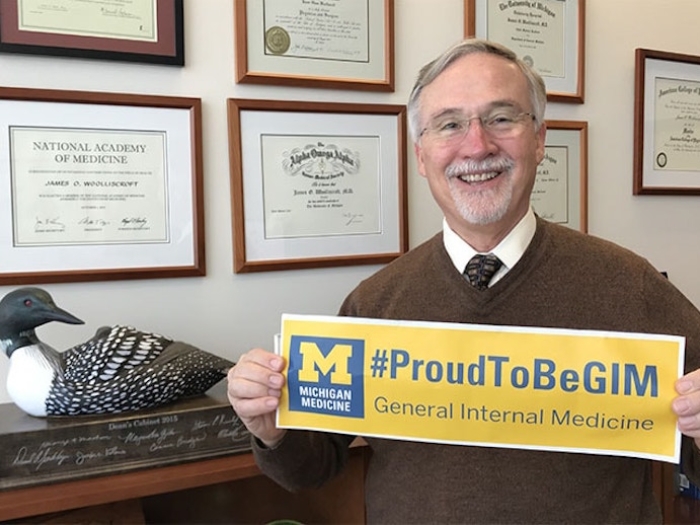General internal medicine physicians are prime drivers of high-quality clinical care, education, research and innovation — which is why U-M faculty say more students should consider the path.
7:00 AM
Author |

When Allison Ruff, M.D., was learning to be a doctor, she wasn't sure what type she wanted to be. So, like many others, she chose an internal medicine residency, which can act as a stepping stone to a wide range of medical careers.
MORE FROM THE LAB: Subscribe to our weekly newsletter
But even as her residency classmates planned their next steps — training to become specialists in heart care, kidney disorders, infectious diseases and other fields — she found herself unsure of which way to go.
That's when a senior doctor she was working with suggested that she shouldn't choose a specialty at all — or rather, that she should choose the specialty of general internal medicine.
"When students think of gen med, as we call it, they think of primary care in an outpatient setting, compared with some fancy specialty career," says Ruff. "They may even worry that they won't be respected or won't earn enough to pay off their medical school loans. But it never crosses their mind that primary care is just one of the things you can do with the training."
Fast-forward a few years to today, when Ruff is already an assistant professor at the University of Michigan Medical School while most of her residency classmates have just finished their specialty training.
She has a full practice of adult patients, many with multiple chronic conditions, who see her as their "quarterback." She's the physician who helps them make sense of all the diagnoses, medicines, tests, procedures and lifestyle changes that she and their specialists recommend.
Her clinic is their medical home, where she manages care for better outcomes and lower total costs, as federal policy incentivizes internal medicine physicians to do.
And every week, she walks from U-M's sprawling complex of clinics and hospitals over to the Medical School's classrooms. There, as a leader in implementing the school's new curriculum, she teaches and advises the medical students who are just starting the journey to discover which kind of physicians they want to be.
When students think of gen med … [they] worry that they won't be respected or won't earn enough to pay off their medical school loans. But it never crosses their mind that primary care is just one of the things you can do with the training.Allison Ruff, M.D.
A place to start many journeys
Ruff hopes that some of these students will start thinking earlier on about pursuing a general medicine career like she did. It's a point she also tries to make when students and first-year internal medicine residents rotate through her clinic during their voyage of learning and discovery that lets them get a taste of all the fields of medicine before choosing a path.
SEE ALSO: 'Why I Became a Doctor': Michigan Medicine Physicians Share Their Stories
"You'll be done with residency in three years, which is especially nice if you have a family, and you can spend the final year perfecting your clinical skills without the distraction of applying for fellowship training in a specialty," she says. "You can start the climb toward a leadership position that much earlier, or start teaching or doing research earlier if you go into an academic medical career, where there is great demand for great general internists. And the idea that you won't be well compensated or able to pay off your loans is untrue."
In fact, she notes, the high demand for general internists means many can negotiate loan forgiveness as part of their hiring packages. Or they can get help with loan repayment from the federal government if they choose a research career or go into practice in a medically underserved area.
Spreading the word
Ruff has teamed up with colleagues including John Z. Ayanian, M.D., M.P.P., and a major professional society to show medical students and residents what they can do if they make the general medicine choice. As part of a national push by the Society of General Internal Medicine, they're holding "ProudtobeGIM" events this week at U-M and other medical schools around the country.
Ayanian is another example of what general medicine physicians can do.
Along with his own research on how health care is delivered through Medicare, Medicaid, and private insurers, Ayanian heads the Institute for Healthcare Policy and Innovation. His public policy degree, which he pursued during medical school, equipped him to look at how health care intersects with government, from regulations to public health insurance.
Now, he leads a campuswide institute that brings together more than 500 U-M faculty from many disciplines who study health care delivery and the impacts of public policy. One in 10 of them are physicians trained in general internal medicine.
Ayanian notes, "My clinical work as a general internist gives me meaningful insights into how our patients are affected by broad policy decisions, and these insights shape the research that my colleagues and I are doing to improve health care for our patients and many others.
"By combining general internal medicine and health policy research, I can serve patients one-on-one with my clinical skills while also promoting more equitable and effective care for communities at the state and national levels."
Changing the model
Some general medicine physicians take their broad clinical skills in a relatively new direction: becoming hospitalists. A rising field in the past two decades, it allows doctors to choose not to have their own outpatient practice, but instead to focus on the care of patients who are hospitalized.
SEE ALSO: Match Day Explained: How Med Students Take the Next Career Step
For more than a century, general internists did both. They shuttled between their office and the floors of nearby hospitals to check on patients they'd been seeing for years as those patients recovered from surgery, a heart attack or a bout with the flu.
But today, with hospital-based medical care growing ever more complex and demand rising for both inpatient and outpatient care, many general internists focus on one setting.
Ruff notes that the three years of internal medicine residency training happen mainly in a hospital setting. That makes it important for private practice and academic internists to help residents understand what an office-based career is like, too.
General medicine is not the only choice for doctors-to-be who want to handle a wide range of care. General internal medicine is considered one of the primary care disciplines, along with pediatrics, family medicine, and general obstetrics and gynecology. Some physicians choose to train in both pediatrics and general medicine, in what's called a "med/peds" route. Each of these routes has unique features.
And as the federal government and private insurers work to incentivize health care teams to provide better care at a lower cost, Ruff says health systems are looking for generalists who can lead innovation from within. It's a message she conveys to the medical students who come through her clinic.
"When they see what I do and that I love it, some of them say, 'Gee, I never considered this as a career, but now I am,'" she says. "We need to show them why general medicine is great and why we love our jobs."

Explore a variety of healthcare news & stories by visiting the Health Lab home page for more articles.

Department of Communication at Michigan Medicine
Want top health & research news weekly? Sign up for Health Lab’s newsletters today!





